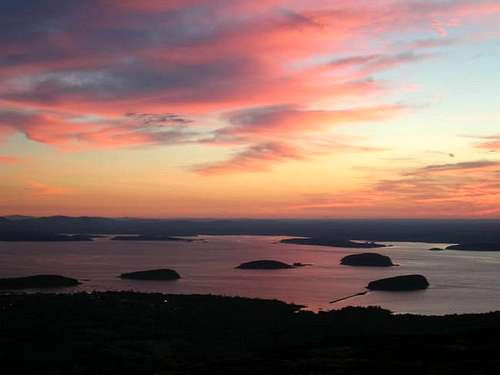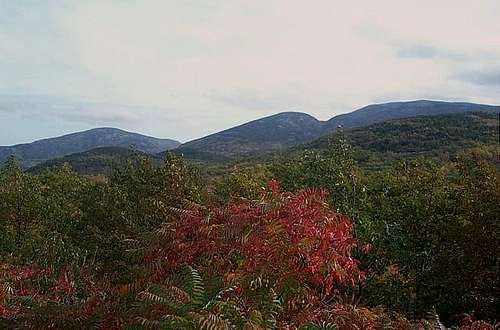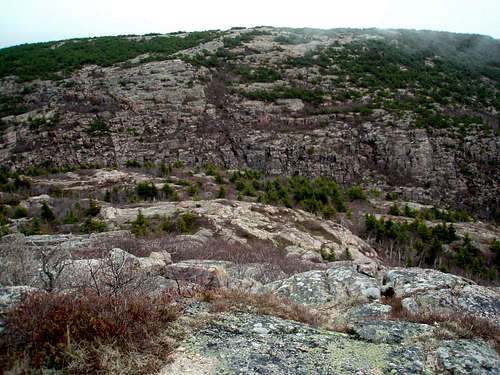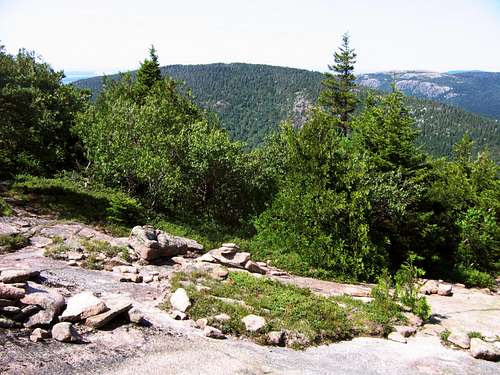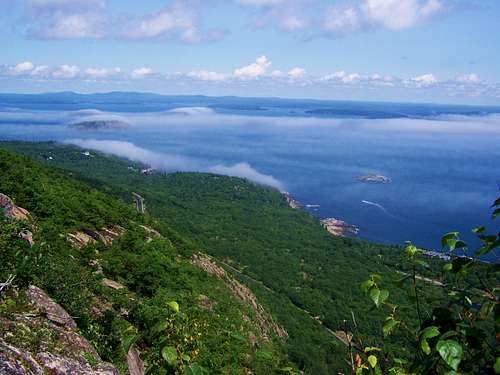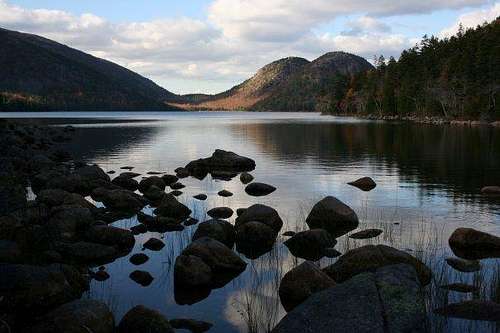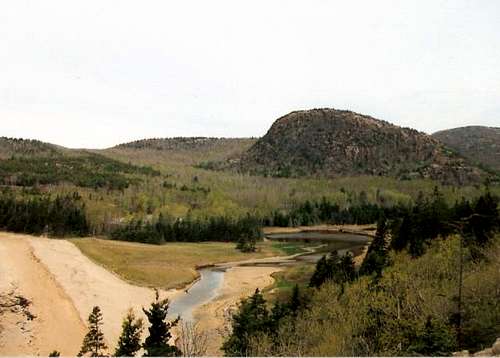-
 33257 Hits
33257 Hits
-
 94.98% Score
94.98% Score
-
 50 Votes
50 Votes
|
|
Area/Range |
|---|---|
|
|
44.35381°N / 68.22166°W |
|
|
Hiking, Mountaineering, Trad Climbing, Toprope, Scrambling |
|
|
Spring, Summer, Fall, Winter |
|
|
Overview
Acadia National Park is located along the rugged coastline of Maine. It was the first national park east of the Mississippi River, and is the site of the highest mountain along the eastern seaboard in North America (Cadillac Mountain). At 1,528 feet, Cadillac mountain is not especially imposing or difficult. But, from October to March, the summit is the spot where light first shines on American each morning. In addition, the many trails in the park with stunning views of the Atlantic coastline make the park a hiker's delight. Old cobblestone carriage roads and seventeen stone bridges also provide a romantic bicycling (or winter skiing!) experience for those so inclined (or one could opt for a lazy respite on a horse-drawn carriage). And, there are some technical climbs out over crashing waves along the seaside cliffs that are the hallmark of this park. Acadia National Park was created as the result of a donation of land by George B. Dorr, a tireless spokesman for conservation. In 1916, President Wilson announced the creation of Sieur de Monts National Monument on that tract of land. Dorr continued to acquire property and renewed his efforts to obtain full national park status for his beloved preserve. In 1919, President Wilson established the area as Lafayette National Park with Dorr as the first park superintendent.
In 1929, the park name changed to Acadia. John D. Rockefeller would donate yet more land, most notable being that on which he had established the carriage roads and stone bridges. Today, the park protects more than 47,000 acres in several areas on Mount Desert Island, as well as on Schoodic Peninsula and Isle Au Haut. Baker Island and Bar Island also have national park land. Although the park is now restricted by federal law from accepting any more land, some adjacent landowners have placed their property into protective easements that restrict future development, thus preserving the region for generations to come.
Getting There
Acadia National Park is located on Mount Desert Island near the town of Bar Harbor, ME. Find your way to I-395 in Bangor, ME, then use the following directions to get to the park (approximately 50 miles): o Mapquest Driving Instructions and Map, Bangor to Acadia National Park While the park is open year-round, in the winter driving access is limited. Most of the park facilities, including most of Park Loop Road (including the road to Cadillac Mountain) are closed during the winter, and at other times when severe weather creates dangerous conditions. For the most current information, visit the official park website page located here: o Acadia National Park NPS Website--Operating Hours and Seasons Once at the park, a free shuttle bus service operates during prime season. Parking in many areas of the park is very limited during busy months, and it is recommended that this service be used whenever possible.
Red Tape
This is a national park, and comes with the usual national park rules and regulations. There is a fee to enter the park from May 1 to October 31. The fee varies depending on date and how the entry is made (bike, drive, etc). Of course, all of the various access passes are accepted. For the most current information, visit the official park website page located here: o Acadia National Park NPS Website--Entrance Fees
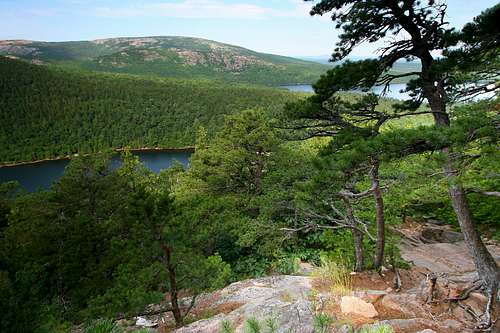 View from the Cadillac West Face Trail on Cadillac Mountain.
View from the Cadillac West Face Trail on Cadillac Mountain.Weather
Spring can be foggy with temperatures ranging between 30° and 70°F. Summer daytime temperatures range from 45° to 90°F. Evenings are cooler. Fall temperatures can range from low 70s during the day to freezing during the night. In the winter, due to Acadia's coastal location, snow and weather conditions change rapidly. Temperatures vary from mid-30s to below zero. The park averages 61 inches of snow annually. Annual rainfall is 48 inches. In summer, ocean water temperatures range from 50° to 60°F. Lake water temperatures range from 55 to 70°F. o Qwikcast.com Five Day Weather Forecast for Bar Harbor, Maine
Camping and Hotels
There are two campgrounds located within the park: Seawall Campground and Blackwoods Campground. Seawall Campground. Seawall Campground provides 214 drive-up tent, camper and motorhome sites. It is located on Route 102A, four miles south of Southwest Harbor, and is open from late May through September 30. There is a fee to camp at Seawall Campground. Reservations are suggested; however, approximately half of the sites are set aside for walk-ins on a first come, first served basis. There are fee showers located nearby. The free park shuttle bus service includes this campground on its route. You can find the most current information and the fee schedule here: o Acadia National Park NPS Website--Camping Blackwoods Campground. Blackwoods Campground offers 306 campsites. It is located on Route 3, five miles south of Bar Harbor. Access, use and fees for this campground vary, depending on the season. It has restrooms with running water, as well as nearby fee showers (both depending on the season). The free park shuttle bus service includes this campground on its route. You can find the most current information and the fee schedule here: o Acadia National Park NPS Website--Blackwoods Campground Reservations. Reservations for Seawall and Blackwoods Campgrounds are handled by the National Recreation Reservation Service. Reservations may be made up to six months in advance. For additional information, use the links to the official park pages for either campground above. Wildwood Stables. Wildwood Stables is operated by a concessionaire to provide camping for those with horses. For more information, visit here: o Acadia National Park NPS Website--Concession Tours
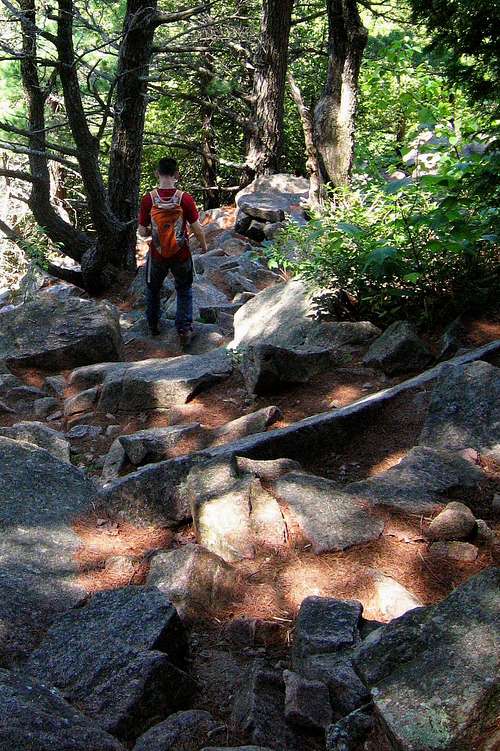 Hiking down the Cadillac West Face Trail.
Hiking down the Cadillac West Face Trail.Duck Harbor Campground. Duck Harbor Campground is located on Isle au Haut, a rugged island off the coast of Stonington, Maine. Remote and inaccessible to automobiles, Isle au Haut is linked to the mainland by mailboat. Five primitive sites are available from May 15 to October 15 by advance reservation. Party size is limited to six persons per site. Lean-to shelters are provided at each site. Use of tents is limited to what can fit inside the shelters. Other facilities include a fire ring, picnic table, composting toilet, and hand pump for water (located 1,600 feet from shelters). Reservations are made by contacting the park directly. You must coordinate your reservation with the mailboat schedule, and it must be postmarked after April 1st (telephone/e-mail requests are not accepted). For more information, visit here: o Acadia National Park NPS Website--Duck Harbor Campground Other Camping and Hotels Outside the Park. There are a number of commercial campgrounds operating outside the park in the local area. Bar Harbor and the surrounding communities are a popular tourist destination; anyone wishing to camp should make advanced reservations, and should be prepared to pay a somewhat higher than normal fee for the privilege. There are also many local hotels. They are, not surprisingly, also expensive.
Hiking
The park is riddled with 125 miles of popular hiking trails, ranging from a level 0.4 mile loop atop Cadillac Mountain, to a grueling ascent on open cliffs using ladders and iron rungs as aids. Many of the summits within the park are accessible by these trails, including the ever popular Cadillac Mountain (which is also accessible by road, but why do that?). The park service provides a list of some of the most popular trails here: o Acadia National Park--Hiking Trails Due to peregrine falcon nesting, some of the trails are closed during certain months. Check the day of a hike with the park rangers for the most current information. Anyone planning to hike in Acadia National Park would do well to have the following map in their possession: o National Geographic Acadia National Park Map #212
Summits
While the mountains in Acadia National Park are not very tall (1,528-foot Cadillac Mountain being the highest), the views along the hiking trails can be quite stunning. What follows is a listing of the peaks that have pages on SP. Each one has a link to the USGS quad topo that shows that particular feature. There are many other lessor summits in this fascinating area. You can use the topos to find other destinations of interest.
Technical Climbing and BoulderingTechnical Climbing. Acadia National Park offers a variety of climbs on small cliffs created during the last continental glaciation. Most of these cliffs are composed of solid coarse-grained pink granite. The longest routes are three pitches. Otter Cliffs and Great Head provide a spectacular setting for sea cliff climbing not commonly found in the U.S. The NPS website provides the following information on specific climbing areas: o Otter Cliffs. 60' sea cliffs, crack and face climbing, rappel access, routes up to 5.12. o South Wall (Champlain). 3-pitch routes to 5.12, good corners and thin cracks. o Central Slabs. 1-pitch routes, some good beginner routes, routes to 5.10. o South Bubble. 1- to 3-pitch routes, some friction climbing, good beginner routes. o Great Head. High-grade sea cliff climbing, rappel access, be aware of tides and weather.  Chimney route on "The Precipice." Image by Rasgoat.More detailed information about technical climbs is available at rockingclimbing.com: o Rockclimbing.com Website Page for Acadia National ParkThe following climber's guides should prove useful for anyone planning technical climbs within the park: o Rock Climbing in Acadia National Park by Pete Warner o Selected Climbs in the Northeast: Rock, Alpine, and Ice Routes from the Gunks to Acadia by S. Peter Lewis and Dave Horowitz o Acadia Rock Climbing Guidebook by Grant Simmons Bouldering. Bouldering opportunities exist by the ocean between Sand Beach and Otter Cliffs, and near Blackwoods Campground.Additional InformationYou may contact Acadia National Park by writing: Acadia National ParkP.O. Box 177Bar Harbor, ME 04609Visitor information at the park can be reached by calling (207) 288-3338. Or, you may complete an online "e-mail" form here. The official park website is located here: o Acadia National Park NPS Website
Chimney route on "The Precipice." Image by Rasgoat.More detailed information about technical climbs is available at rockingclimbing.com: o Rockclimbing.com Website Page for Acadia National ParkThe following climber's guides should prove useful for anyone planning technical climbs within the park: o Rock Climbing in Acadia National Park by Pete Warner o Selected Climbs in the Northeast: Rock, Alpine, and Ice Routes from the Gunks to Acadia by S. Peter Lewis and Dave Horowitz o Acadia Rock Climbing Guidebook by Grant Simmons Bouldering. Bouldering opportunities exist by the ocean between Sand Beach and Otter Cliffs, and near Blackwoods Campground.Additional InformationYou may contact Acadia National Park by writing: Acadia National ParkP.O. Box 177Bar Harbor, ME 04609Visitor information at the park can be reached by calling (207) 288-3338. Or, you may complete an online "e-mail" form here. The official park website is located here: o Acadia National Park NPS Website
SP Image Summit Name Photographer | SP Page | USGS Quadrangle |
| Mountain Description | ||
|---|---|---|
Cadillac Mountain (1528 feet) is the highest on the U.S. eastern seaboard. In the winter it has the earliest U.S. sunrise. It is the highest elevation of Acadia National Park. The island and mountains were identified by Samuel de Champlain in 1604 as Mont Desert., meaning barren mountain. The top is still fairly bare and provides a good outlook into Frenchman Bay and Penobscot Bay--great sunset vistas. | ||
Dorr Mountain (1265 feet) is the second highest peak in the park. There are multiple trails that will take you through the four different zones on the mountain (Hardwood forest, hemlock, mixed pine, birch grove, and alpine). There are also two "scramble" trails that lead to the open summit, a loop trail that will take you through a glacial gorge around the base of the mountain, and many "hidden" trails (such as Homan's Path) that were created early in the park's history but for some reason became inactive and are not depicted on most maps. An additional geological feature at the eastern base of Dorr Mountain is a glacial-melt pond called The Tarn. | ||
Pemetic Mountain (1248 feet) is the third highest summit in the park. Several short hikes lead up the mountain from all sides, and can be combined with other summits in the park. The views of Bubble Rock, Jordan Pond, Cadillac Mountain, Seal Harbor, Somes Sound and the Cranberry Islands from the summit are expansive and inspiring. | ||
Champlain Mountain (1058 feet) rises dramatically above the Atlantic Ocean. It can be climbed from two of the most popular trailheads in the park (both start about 100-feet above sea level). The sunrises and fall colors from Champlain Mountain can be quite impressive. Nearby Sand Beach, the only natural sand beach on Mount Desert Island, and the Beehive, are nearby destinations that can be combined with Champlain Mountain to fill out a great day. | ||
The Bubbles (830 feet) are a pair of peaks that stand side-by-side with only a narrow saddle separating one from the other. The summits are rocky, largely bare, and stand in great relief above Jordan Pond. The views from the tops are some of the finest in Acadia, and while they are not the highest peaks in the vicinity, they are still impressive and offer great vantage points of the area around Jordan Pond and views toward the Atlantic. The view of The Bubbles from various points in the park is also quite notable, as their distinctive outline and shape give them their unusual name. | ||
The Beehive (520 feet) is the dominant geologic feature you see from the area near Sand Beach. To get to the top is a short but steep and very fun hike. The trail is rated as strenuous and is a bit of a cliffhanger, but any hiker in decent physical shape who isn't afraid of heights and who takes their time should be able to do it. | ||


